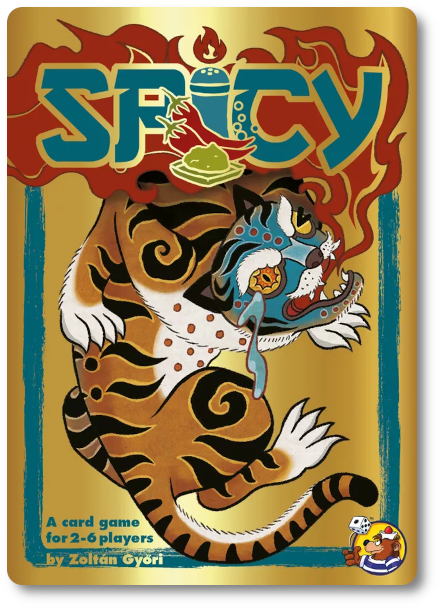 The Basics:
The Basics:
- For players 8 and up (publisher suggests 10+)
- For 2 to 6 players
- Approximately 15 minutes to complete
Geek Skills:
- Active Listening & Communication
- Logical & Critical Decision Making
- Pattern/Color Matching
- Strategy & Tactics
- Risk vs. Reward
- Hand/Resource Management
- Self-confidence
- Bluffing and Misdirection
Learning Curve:
- Child – Easy
- Adult – Easy
Theme & Narrative:
- This is a game of bluffing and clever hand management that has a lot of heat
Endorsements:
- Gamer Geek approved!
- Parent Geek approved!
- Child Geek approved!
Overview
In this game, players will attempt to bluff their way to the winner’s circle by balancing truth with fiction, creating an ever-growing possibility that their little lies and cheats will blow up in their faces. Telling the truth is always best, but it won’t grant you victory. What will is keeping a straight face and not sweating when the heat is cranked up via the competition.
Spicy, designed by Győri Zoltán Gábor and published by HeidelBÄR Games, is comprised of 110 cards. The cards are as thick and durable as your standard playing card but are far from “standard.” The backs of the cards have a glossy metallic finish that makes you go “Ooooh!” and the artwork by Jimin Kim is highly stylized and intriguing. Excellent stuff.
Note: Spicy is the more complicated version of Sweet and Spicy. If you are looking for the same kind of game described here but a bit more friendly to families and casual players, check out Sweet and Spicy.
Preparing for a Scorcher
To set up the game, complete the following steps:
First, separate the cards. There are three sets of 30 cards called “Spicy cards.” These represent three spicy suits—specifically chili, wasabi, and pepper. There are also five “Wild Spice” and five “Wild Number” cards. Put the Spice and Wild cards together. You’ll also find three “Trophy” and one “World’s End” card. Set these four cards aside for the moment.
Second, take all those gorgeous Spicy and Wild cards and shuffle the bejesus out of them. This is especially necessary if you have played the game recently.
Third, deal six Spicy cards to each player face-down. Players should feel free to pick up and look at their cards but should keep them hidden until played.
Fourth, place the remaining cards face-down in the playing area. This is the Spicy draw deck for the duration of the game.
Fifth, place the World’s End card next to the draw deck. You’ll see a small gauge on the World’s End card. Using that gauge, put the World’s End card into the draw deck based on the number of players. This card will trigger the endgame once it’s revealed.
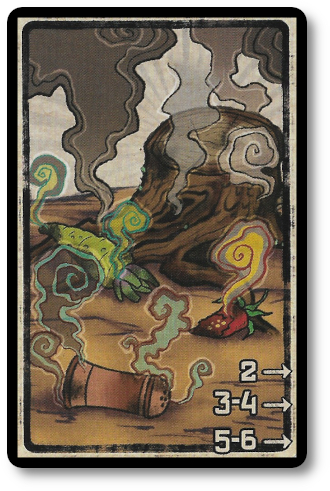
Sixth, place the three Trophy cards next to the draw deck and within easy reach of all the players.
That’s it for game setup. Determine who will go first and begin.
Playing with Fire
Spicy is played in turns with no set number of turns per game. On a player’s turn, they can either play a card from their hand or pass.
The objective of Spicy is to earn Trophy cards and Spicy cards. This is done through clever card plays and bluffing. To play a card, the player need only take one Spice card from their hand, place it face-down in a single stack that all players play to, and declare its number value (1 – 10) and its spicy suit (chili, wasabi, or pepper). If this is the first card played to the stack, the number noted should be one, two, or three.

The above Spice card, for example, is a “10 of Wasabi.”
When declaring a number value, it must be higher than the previous number value stated by an opponent and match the current suit. For example, if the opponent played a “four of chili,” the player needs to play a five or higher of the same suit.
But maybe they don’t or can’t.
A player is always welcome to bluff (that is, lie) about what card they are playing. This gameplay aspect is essential as there is little chance the player has the right cards. Using the same example noted previously if the opponent played a “four of chili,” the player must say they are playing a five or higher of the same suit. In reality, it could be any number or suit.
They can also play a Wild card if they like. These special Spice cards represent all the number values or all the spices, not both.
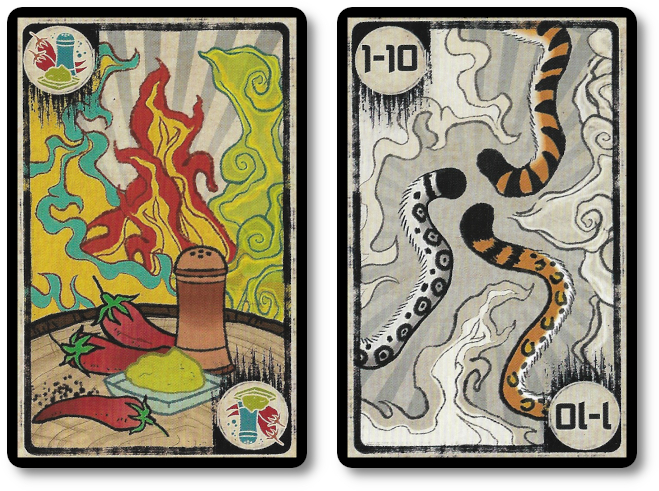
The one exception to the rule that requires players to always play a card with a higher number value is when the last card number value announced was a “1o” of whatever suit is currently in play. At this point, the next player must play a one, two, or three of a card of the current suit.
Players are also welcome to pass on their turn instead of playing a card. If the player does decide to take this action, they announce it to the table and draw one card from the Spicy draw deck, adding it to their hand.
This completes the player’s turn, but they are not done yet.
Challenging the Hotness
A player may challenge the previous card played at any time during the game, even out of turn. To do so, they announce, “I challenge.” This indicates that the player challenging does not believe that the last card played to the stack was accurately announced. That is to say, they believe their opponent is a liar. The challenger, however, needs to be specific regarding what fact is misrepresented. In this case, the player must announce they challenge the previously played card’s number value or spice suit. Not both.
For example, “I challenge. I don’t think the last card played was an eight.”
Once the challenge has been announced, the top-most card played to the stack is revealed.
- The challenge winner collects all the cards in the stack (including the challenged card) but keeps them face-down in front of them. At the end of the game, these cards award the player points. The player then draws six cards, adding them to their hand.
- The loser of the challenge draws two cards from the Spicy draw deck, adding them to their hand. They then start a new stack.
Trophy Time
If a player ever plays the last card in their hand and successfully wins what will most certainly be a challenge from an opponent, they collect one of the Trophy cards, if any are still available. The Trophy card remains in front of the player for the duration of the game.
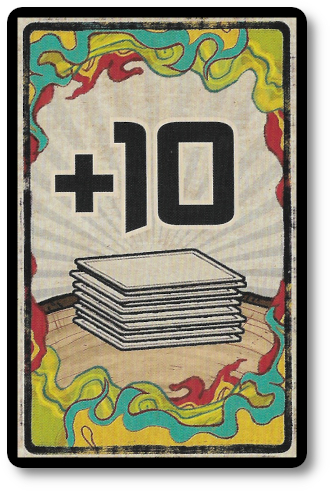
A Painful Ending
The game can end in one of several ways:
- A player takes their second Trophy card
- A player takes the last Trophy card available
- The World’s End card is drawn (reveal this card to all the players at the table once drawn)
The players now determine their score for the game.
- If the player has two Trophy cards, they win the game.
- If no player has two Trophy cards, all the players determine their final score by counting the total number of Spicy cards they collected, with each Spicy card counting as one point—any Trophy cards earned count as 10 points.
- Subtract one point for every card still in the player’s hand.
The player with the most points wins the game!
Game Variant to Spicy It Up
After playing the base game, you might want to add more spice. Good news! The game has a variant that allows players to change one or more basic rules through thoughtful selection or random draws. This is done using the Spice It Up cards. Each card represents one change to the rules. Players can use one, two, or all to crank the temperature.
For example, the following card is titled ” “Spice Raider.” It adds the rule that a player must put their hand on the Spice card played if they declared it to have a number value of “four.” This forces all the other players to consider whether it is worth challenging. If the player is not challenged by their opponents, they win all the cards in the stack.
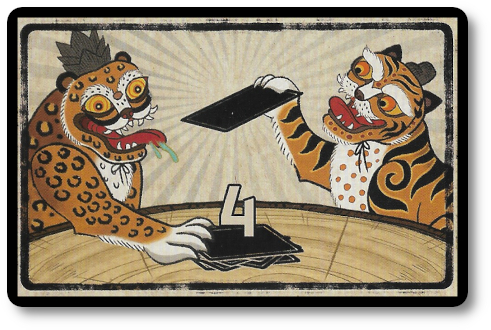
To learn more about Spicy, visit the game publisher’s website.
Final Word
 The Child Geeks quickly learned and enjoyed the game, finding it fast, intuitive, and fun to trick and trounce their opponents. According to one Child Geek, “The game was easy to understand right away, and I liked how easy it was to follow. When I played with my mom, I even won!” Another Child Geek said, “I was told never to lie, but I am proud to say that I was an excellent liar in this game and wasn’t told I was naughty. You have to be a bit naughty in this game but not mean. Just naughty, which I didn’t mind.” When the last spicy jar was returned to the shelf, the Child Geeks evaluated their experience and found the game to be hot fun at the family gaming table.
The Child Geeks quickly learned and enjoyed the game, finding it fast, intuitive, and fun to trick and trounce their opponents. According to one Child Geek, “The game was easy to understand right away, and I liked how easy it was to follow. When I played with my mom, I even won!” Another Child Geek said, “I was told never to lie, but I am proud to say that I was an excellent liar in this game and wasn’t told I was naughty. You have to be a bit naughty in this game but not mean. Just naughty, which I didn’t mind.” When the last spicy jar was returned to the shelf, the Child Geeks evaluated their experience and found the game to be hot fun at the family gaming table.
 The Parent Geeks also enjoyed the game, finding the hand management and bluffing gameplay aspects satisfying and challenging. According to one Parent Geek, “Because the number range is small and there are only three suits, you must listen and be crafty about your card plays. It would help if a player counted cards, but that feels unnecessary as the games are fast and engaging. Who has the time or energy to count a card or three when the real fun is at the table with the players?” Another Parent Geek responded by saying, “Oh, I agree. I tried to count a few cards, keep track of the suits and the number values for each, and quickly lost interest. It is much more fun to go with your gut, try to put on your best Poker face, and do all you can to win. Fun!” After several spicy games, the Parent Geeks took a vote, and everyone decided that Spicy had a real kick.
The Parent Geeks also enjoyed the game, finding the hand management and bluffing gameplay aspects satisfying and challenging. According to one Parent Geek, “Because the number range is small and there are only three suits, you must listen and be crafty about your card plays. It would help if a player counted cards, but that feels unnecessary as the games are fast and engaging. Who has the time or energy to count a card or three when the real fun is at the table with the players?” Another Parent Geek responded by saying, “Oh, I agree. I tried to count a few cards, keep track of the suits and the number values for each, and quickly lost interest. It is much more fun to go with your gut, try to put on your best Poker face, and do all you can to win. Fun!” After several spicy games, the Parent Geeks took a vote, and everyone decided that Spicy had a real kick.
 The Gamer Geeks, also fans of hand management and bluffing games, were immediately skeptical as Spicy isn’t a tough game when you describe it, let alone teach it. Some of our gaming elitists believed it to be too simple, making their surprise enjoyment all the more special. As one Gamer Geek put it, “Make no mistake, my fellow gaming elitists, the game is exactly as described. Play a card and hope for the best. But in this case, you need to bluff, even when you are telling the truth. You need to trick people into thinking you are lying just as much as you need to trick people into believing you are not. This was a card game much more enjoyable than I originally expected.” Another Gamer Geek said, “Simple in its execution and highly entertaining delivery. It was a fast and casual game of bluffing, ducking, and dodging that made me smile, growl, and shout for joy. I’d play this again with my gaming friends, non-gaming friends, and – heck – even my mother.” After the Gamer Geeks took big gulps of milk to help with the pain of defeat, they all agreed that Spicy was a game with some genuine heat.
The Gamer Geeks, also fans of hand management and bluffing games, were immediately skeptical as Spicy isn’t a tough game when you describe it, let alone teach it. Some of our gaming elitists believed it to be too simple, making their surprise enjoyment all the more special. As one Gamer Geek put it, “Make no mistake, my fellow gaming elitists, the game is exactly as described. Play a card and hope for the best. But in this case, you need to bluff, even when you are telling the truth. You need to trick people into thinking you are lying just as much as you need to trick people into believing you are not. This was a card game much more enjoyable than I originally expected.” Another Gamer Geek said, “Simple in its execution and highly entertaining delivery. It was a fast and casual game of bluffing, ducking, and dodging that made me smile, growl, and shout for joy. I’d play this again with my gaming friends, non-gaming friends, and – heck – even my mother.” After the Gamer Geeks took big gulps of milk to help with the pain of defeat, they all agreed that Spicy was a game with some genuine heat.
 Oh, what fun! It’s another game where I need to lie!
Oh, what fun! It’s another game where I need to lie!
That was sarcasm.
Sarcasm, I must add, that quickly became unfounded. Some of my players said that Spicy was casual. I found it to be the opposite. There were times in the game when I felt downright stressed. This is where your Poker face skills come into play, my friends. You will need to lie in the game, but more importantly, determine if your opponents are lying. Watch those faces, observe their body language, and never let your opponents believe you are faking it. Unless, of course, you want them to.
This is why the game is so enjoyable: the deception. Bluffing games require players to keep a neutral face and act like they are playing it straight while every player at the table knows that they are being lied to. But by whom? And when they do know, should they say or let it slide? Better yet, because the decision-making in this game is so light, turns are fast and furious. You’ll need to decide fairly quickly whether you want to challenge. Either way, each moment of being caught in the lie or catching the liar comes soon to the front and pulls the player in.
The result is a great card game that all of our players enjoyed. Do try Spicy when the opportunity presents itself. I hope you don’t get burned!
This game was given to Father Geek as a review copy. Father Geek was not paid, bribed, wined, dined, or threatened in vain hopes of influencing this review. Such is the statuesque and legendary integrity of Father Geek.




Pingback: Sweet and Spicy Game Review - Father Geek